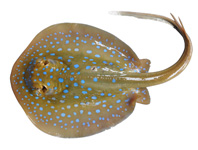Abstract
An investigation of combined CO1 and NADH2 data for rajid skates referable to Raja miraletus provided evidence that populations ranging from southern Africa to the North-East Atlantic and Mediterranean Sea, once considered to represent a cline, belong to a species complex consisting of at least four valid species. Raja miraletus appears to be confined to the Mediterranean Sea, and the North-East Atlantic from the Bay of Biscay south to Morocco and Madeira. The southernmost species, referable to the resurrected Raja ocellifera, occurs off southern Africa, off Namibia and from False Bay to Durban (South Africa). Two species occur off tropical West Africa, including Raja parva sp. nov. (Senegal, Liberia and Angola but is probably more widespread within the region), and another unidentified species needing further investigation. Raja cf. miraletus, confirmed from Mauritania and Senegal, appears to be a larger skate with a broader disc, more broadly pointed snout, larger spiracles, and a slightly longer and broader tail. Raja parva sp. nov. differs from nominal members of the complex in having an unusually long procaudal tail (exceeding 22% TL), as well as a combination of other external characters. Past investigators observed morphological and anatomical differences between these forms but these were thought to be due to intraspecific variability. They postulated that an upwelling at Cape Blanco (21°N) may have isolated the Mediterranean form (R. miraletus) from Mauritania-Senegal form (now known to be two species). Similarly, the Benguela Current and upwelling off Cape Frio (18°S) were thought to be responsible for separating the Angolan form (R. parva) and South African form (R. ocellifera).
References
Compagno, L.J.V., Ebert, D.A. & Smale, M.J. (1989) Guide to the Sharks and Rays of Southern Africa. Struik Publishers, Cape Town, 160 pp.
Eschmeyer, W.N., Fricke, R. & Laan, R. van der (Eds.) (2016) Catalog of fishes: genera, species, references. Available from: http://researcharchive.calacademy.org/research/ichthyology/catalog/fishcatmain.asp ( accessed 17 Jun 2016)
Fricke, R. & Eschmeyer, W.N. (2016) Guide to fish collections. Available from: http://researcharchive.calacademy.org/research/ichthyology/catalog/collections.asp ( accessed 17 Jun 2016)
Hubbs, C.L. & Ishiyama, R. (1968) Methods for taxonomic study and description of skates (Rajidae). Copeia, 1968 (3), 483–491.
http://dx.doi.org/10.2307/1442016Ishiyama, R. (1958) Studies on the rajid fishes (Rajidae) found in the waters around Japan. Journal of the Shimonoseki Collection of Fishes, 7, 191–394.
Ishihara, H. (1987) Revision of the western North Pacific species of the genus Raja. Japanese Journal of Ichthyology, 34, 241–285.
Last, P.R., Séret, B., Stehmann, M.F.W. & Weigmann, S. (in press) Skates, Family Rajidae. In: Last, P.R., White, W.T., Carvalho, M.R. de, Séret, B., Stehmann, M.F.W & Naylor, G.J.P (Eds.), Rays of the World. CSIRO Publishing, Melbourne.
Last, P.R., White, W.T., Pogonoski, J.J. & Gledhill, D.C. (2008) New Australian skates (Batoidea: Rajoidei) – background and methodology. In: Last, P.R., White, W.T., Pogonoski, J.J. & Gledhill, D.C. (Eds.), Descriptions of New Australian Skates (Batoidea: Rajoidei). CSIRO Marine & Atmospheric Research Paper, 021, pp. 1–8.
McEachran, J.D., Seret, B. & Miyake, T. (1989) Morphological variation within Raja miraletus and status of R. ocellifera (Chondrichthyes, Rajoidei). Copeia, 1989 (3), 629–641.
http://dx.doi.org/10.2307/1445490McEachran, J.D. & Fechhelm, J.D. (1982) A new species of skate from western Australia with comments on the status of Pavoraja Whitley, 1939 (Chondrichthyes: Rajiformes). Proceedings of the Biological Society of Washington, 95, 1–12.
Naylor, G.J.P., Caira, J.N., Jensen, K., Rosana, K.A.M., Straube, N. & Lakner, C. (2012a) Elasmobranch phylogeny: a mitochondrial estimate based on 595 species. In: Carrier, J.C., Musick, J.A. & Heithaus M.R. (Eds.), Biology of Sharks and Their Relatives, Second Edition. CRC Press, Boca Raton, pp. 31–56.
http://dx.doi.org/10.1201/b11867-4Naylor, G.J.P., Caira, J.N., Jensen, K., Rosana, K.A.M., White, W.T. & Last, P.R. (2012b) A DNA sequence-based approach to the identification of shark and ray species and its implications for global elasmobranch diversity and parasitology. Bulletin of the American Museum of Natural History, 367, 1–262.
http://dx.doi.org/10.1206/754.1

